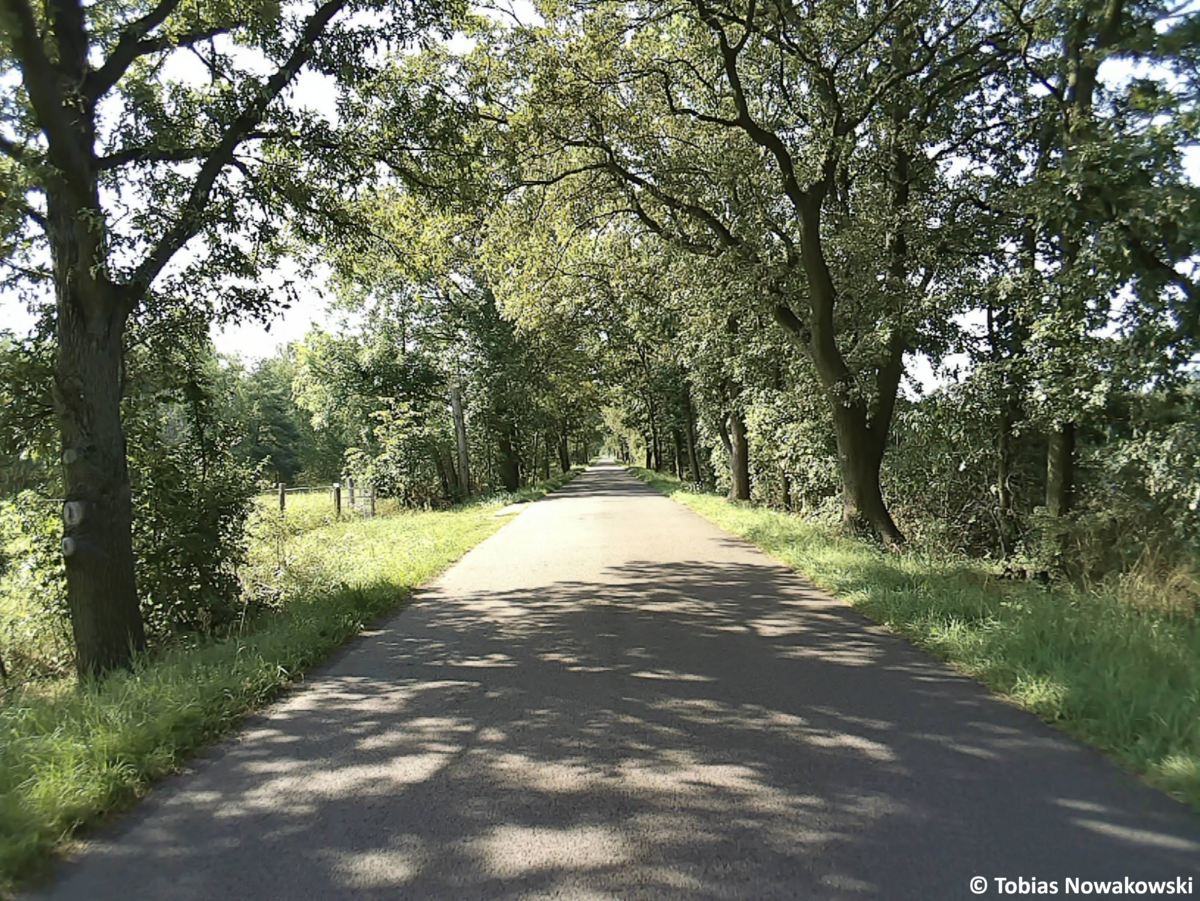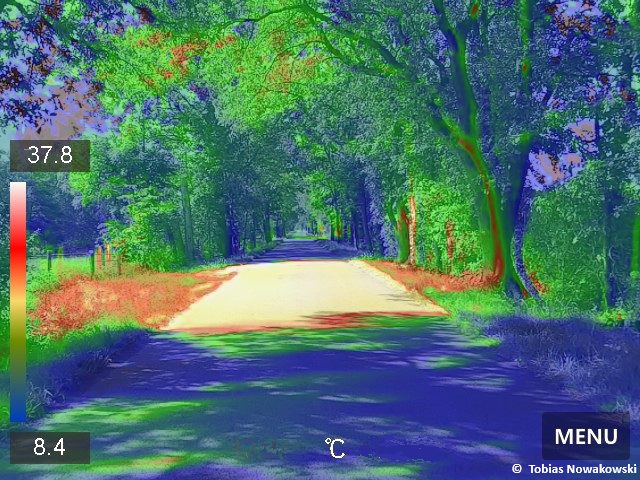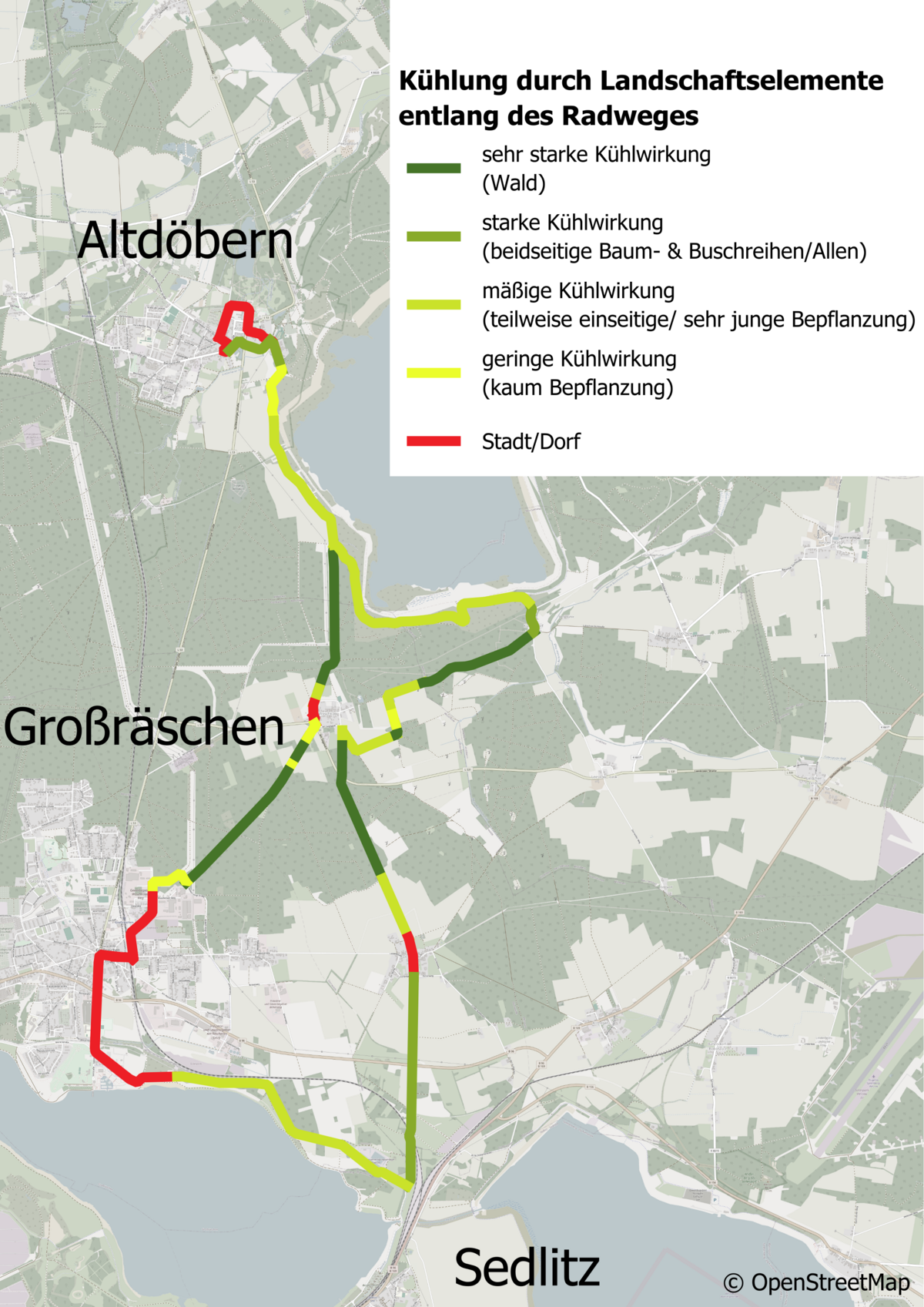"Cool lane" - Germany's first cycle path adapted to climate change
In the research project "Landscape innovations in Lusatia for a climate-adapted bioeconomy and nature-based bioeconomy tourism" (LIL-KliBioTo), scientists from the Leibniz Centre for Agricultural Landscape Research (ZALF) and the Brandenburg University of Technology Cottbus-Senftenberg (BTU) developed the first climate change-adapted cycle path in Germany. The researchers' aim is to use the example of Lusatia to show how cycle paths should be designed in order to adapt them to climate change throughout Germany.
Thanks to the developing lake landscape and diverse, well-developed themed cycle paths, nature-based, cycle-related tourism in Lusatia is highly attractive. At the same time, Lusatia is one of the regions in Central Europe where the frequency and duration of periods of high temperatures in summer will increase as a result of climate change.
"In view of the increasing number of hot summer days due to climate change, measures must also be taken in cycle tourism to ensure that cycling holidays in Germany and Lusatia remain attractive even in midsummer," explains Prof. Frank Wätzold, Chair of Economics, in particular Environmental Economics at BTU Cottbus-Senftenberg.
"Such measures range from appropriate routing - through forests, for example - to the annex of drinking fountains and the planting of shady landscape elements such as trees along cycle paths," explains Prof. Sonoko Bellingrath-Kimura from the Leibniz Centre for Agricultural Landscape Research (ZALF).
Drones provided the researchers with insights into the temperature effects of forests, tree rows, hedgerows, agricultural areas, river courses and settlement areas via thermal images. "We identified temperature hot and cold spots," says Bellingrath-Kimura. "The cycle path mainly runs along cooler stretches between Lake Altdöbern and Lake Großräschen."
When planning the new "Kühle Spur" cycle path, the scientists also took into account the views of the users of the cycle path when it came to the length of the route, the integration of relevant points of interest (POIs) such as the IBA terraces in Großräschen and the Alt Döbern castle park, as well as existing rest and bathing facilities, drinking water dispensers and public transport connections.
For the economic evaluation of the measures, the scientists surveyed cycle tourists to record their preferences for various adaptation measures - such as planting trees and hedges along cycle paths.
The route is signposted by the Lusatian Lakeland Tourism Association and can already be viewed at: www.lausitzerseenland.de/de/erleben/radfahren/thematische-tagestouren/artikel-kuehle-spur-auf-schattigen-wegen-durch-die-lausitzer-seenlandschaft.html
About the project
In order to fund the Lusatia region, the project "Landscape innovations in Lusatia for a climate-adapted bioeconomy and nature-based bioeconomy tourism", or LIL-KliBioTo for short, supports the adaptation of the bioeconomy and cycle tourism to a changing climate. The interdisciplinary research project started at the end of 2022 and is coordinated by the Leibniz Centre for Agricultural Landscape Research (ZALF, Ecosystem Service Provision working group). The project partners are the Chair of Environmental Economics at the Brandenburg University of Technology Cottbus-Senftenberg (BTU) and the company hyperworx Medienproduktionen. The project will run until the end of October 2025.
LIL-KliBioTo is being carried out as part of the "Land-Innovation-Lausitz" (LIL) research alliance, which is funded by the Federal Ministry of Research, Technology and Space (BMFTR) as part of the "WIR! - Wandel durch Innovation in der Region" programme. Land-Innovation-Lausitz (LIL) is coordinated by ZALF and BTU and aims to strengthen the climate adaptation of land use in Lusatia with the help of innovative technologies and sustainable forms of utilisation. The aim is to apply bioeconomy principles, i.e. the sustainable use of biomass or biogenic raw materials to manufacture products, develop applications or provide services. More than 60 partners from research, business, agriculture, politics and administration are currently working together on this. The research and development projects focus on the innovation areas of soil, plants and materials, the integration area of cultural landscape and the cross-sectional area of digitalisation and sensor technology. The project teams come from science and practice and conduct research into resource-efficient cultivation systems, drought stress-resistant crops and bio-based plastics, among other things.
About the scientists
Prof. Dr Sonoko Dorothea Bellingrath-Kimura
Sonoko Bellingrath Kimura has been at ZALF since 2015, co-head of the "Land Use and Governance" programme area and holds a professorship for land use systems at Humboldt University in Berlin. She received her PhD from Hokkaido University, Japan in 2005, worked at Tokyo University of Agriculture and Technology as Associate Professor from 2004-2015 and has conducted research on nutrient cycling of different cropping systems in temperate regions, tropics and sub-tropics. Her research focus at ZALF is the ICT-based analysis of synergies and trade-offs of ecosystem services and biodiversity for a balanced use of the agricultural landscape. Among other things, she is a board member of the Society for Crop Science (elected as the next president), a member of the Soil Protection Commission and an associate member of the Science Council of Japan.
https://www.zalf.de/de/ueber_uns/mitarbeiter/Seiten/bellingrath-kimura_s-d.aspx
Prof. Dr Frank Wätzold
Frank Wätzold has held the Chair of Economics, in particular Environmental Economics, at BTU since 2010. He received his doctorate from the Free University of Berlin in 1997 and was a scientist at the Helmholtz Centre for Environmental Research until 2009 and Professor of Landscape Economics at the University of Greifswald from 2009 to 2010. His fields of study are the economic analysis of policy instruments for the protection of biodiversity and ecosystem services and the economics of climate adaptation. Frank Wätzold was and is active in various committees for scientific and policy advice, including as a member of the Biodiversity and Genetic Resources Advisory Board of the Federal Ministry of Food and Agriculture from 2015-2025.
https://www.b-tu.de/fg-umweltoekonomie/team/teammitglieder/frank-waetzold
Contact Project LIL-KliBioTo
Leibniz Centre for Agricultural Landscape Research (ZALF) e.V.
Project management:
Prof. Dr Sonoko D. Bellingrath-Kimura
E belks(at)zalf.de
Project coordination:
Tsvetelina Krachunova
E Tsvetelina.Krachunova(at)zalf.de
BTU Cottbus-Senftenberg, Chair of Economics, in particular Environmental Economics
Project management:
Prof. Frank Wätzold
E waetzold(at)b-tu.de
Project coordination:
Tobias Nowakowski
E nowakowt(at)b-tu.de
Contact:
Coordination office WIR! alliance "Land-Innovation-Lausitz" (LIL)
Leibniz Centre for Agricultural Landscape Research (ZALF) e. V. or BTU
www.land-innovation-lausitz.de
Project coordination:
Dr Thomas Maurer
E maurer(at)b-tu.de
Dr Luise Porst
E luise.porst(at)zalf.de
Communication:
Tanja Kollersberger tanja.kollersberger(at)zalf.de
Leibniz Centre for Agricultural Landscape Research (ZALF) e.V.
Eberswalder Str. 84
15374 Müncheberg



